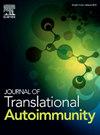Association of COVID-19 with Thyroid Dysfunction and Autoimmune Thyroid Disease: A Retrospective Cohort Study
IF 3.6
Q2 IMMUNOLOGY
引用次数: 0
Abstract
Background
Since the end of the COVID-19 pandemic, the potential roles of thyroid-inflammatory derangements in driving or being associated with the prognosis of COVID-19 remain controversial. We aimed to clarify the association between COVID-19 infection and thyroid dysfunction, and highlight the impacts of subsequent autoimmune thyroid disease (AITD) on the prognosis of COVID-19.
Methods
The retrospective, multicenter, cohort study enrolled 2,339 participants with COVID-19 from three hospitals located in the north, middle, and south regions of Shaan Xi Province, China, between December 2022 and July 2023. 464 non-COVID-19 patients within the same period were supplemented, divided into groups with and without AITD. At hospital admission (baseline), 3- and 6-month follow-ups, we presented a dynamic description and correlation analysis of thyroid-inflammatory-autoimmune derangements in patients with AITD.
Results
A total of 2,082 COVID-19 patients diagnosed with AITD and 257 cases without AITD were included in the study, and 464 non-COVID-19 patients were supplemented, dividing into 14 AITD and 450 non-AITD cases. We found that COVID-19 infection was closely associated with thyroid dysfunction (χ2 = 1518.129, p = 0.000). AITD patients with COVID-19 showed a higher prevalence of symptoms and comorbidities and longer hospital stays at baseline than non-AITD patients with COVID-19 (p = 0.000, p = 0.000, and p = 0.000). The baseline free triiodothyronine (FT3), free thyroxine, and radioactive iodine uptake at 24 hours in AITD cases significantly decreased (p = 0.000, p = 0.000, and p = 0.000), while thyroid stimulating hormone, thyroglobulin, reverse triiodothyronine (rT3), and thyroid antibodies varying elevated from the baseline to the follow-up (baseline: p = 0.000, p = 0.000, p = 0.000, p = 0.000, p = 0.000, and p = 0.000; 3-month follow-up: p = 0.000, p = 0.000, p = 0.000, p = 0.000, p = 0.030, and p = 0.000). C-reactive protein, calcitonin, interleukin-6, -8, -10, and tumor necrosis factor-α rose significantly at baseline (p = 0.000, p = 0.000, p = 0.000, p = 0.000, p = 0.000, and p = 0.000) in AITD. Interferon-α and interferon-γ at baseline showed a significant decrease (p = 0.000 and p = 0.000), and remained at low levels after 6 months (p = 0.000 and p = 0.000). FT3 and rT3 were positively and negatively correlated with hospitalization, respectively (r = -0.208, 0.231; p = 0.000, p = 0.000). ROC curves showed that FT3 and rT3 had better robustness in predicting severe COVID-19 prognosis (AUC = 0.801, 0.705). Ordered logistic regression revealed that ORs were 0.370, 0.048, and 0.021 for AITD [(subacute thyroiditis, Grave’s disease, and Hashimoto’s thyroiditis compared to non-thyroidal illness syndrome (NTIS)] with COVID-19 risk, indicating that NTIS was the predominant risk factor for the severity of COVID-19.
Conclusions
A robust association has been identified, wherein COVID-19 infection is closely associated with thyroid dysfunction, and the subsequent AITD may aggravate the poor prognosis of COVID-19.
COVID-19 与甲状腺功能障碍和自身免疫性甲状腺疾病的关系:一项回顾性队列研究
背景自COVID-19大流行结束以来,甲状腺炎症失调在COVID-19预后中的潜在驱动作用或相关作用仍存在争议。我们旨在阐明 COVID-19 感染与甲状腺功能障碍之间的关联,并强调后续自身免疫性甲状腺疾病(AITD)对 COVID-19 预后的影响。同期补充了464名非COVID-19患者,分为AITD组和非AITD组。在入院(基线)、3个月和6个月的随访中,我们对AITD患者的甲状腺炎症-自身免疫失调情况进行了动态描述和相关分析。我们发现,COVID-19感染与甲状腺功能障碍密切相关(χ2 = 1518.129,P = 0.000)。与感染 COVID-19 的非 AITD 患者相比,感染 COVID-19 的 AITD 患者的症状和合并症发生率更高,基线住院时间更长(p = 0.000、p = 0.000 和 p = 0.000)。AITD 病例的基线游离三碘甲状腺原氨酸(FT3)、游离甲状腺素和 24 小时放射性碘摄取量显著下降(p = 0.000、p = 0.000 和 p = 0.000),而促甲状腺激素、甲状腺球蛋白、反向三碘甲状腺原氨酸(rT3)和甲状腺抗体从基线到随访期间均有不同程度的升高(基线:P = 0.000、p = 0.000、p = 0.000、p = 0.000、p = 0.000 和 p = 0.000;3 个月随访:p = 0.000、p = 0.000、p = 0.000、p = 0.000、p = 0.030 和 p = 0.000)。AITD 患者的 C 反应蛋白、降钙素原、白细胞介素-6、-8、-10 和肿瘤坏死因子-α 在基线时显著升高(p = 0.000、p = 0.000、p = 0.000、p = 0.000 和 p = 0.000)。基线时的干扰素-α和干扰素-γ显著下降(p = 0.000 和 p = 0.000),6 个月后仍保持在较低水平(p = 0.000 和 p = 0.000)。FT3 和 rT3 分别与住院治疗呈正相关和负相关(r = -0.208, 0.231; p = 0.000, p = 0.000)。ROC 曲线显示,FT3 和 rT3 在预测严重 COVID-19 预后方面具有更好的稳健性(AUC = 0.801,0.705)。有序逻辑回归显示,AITD[(亚急性甲状腺炎、格雷夫病和桥本氏甲状腺炎与非甲状腺疾病综合征(NTIS)相比)与 COVID-19 风险的 OR 值分别为 0.370、0.048 和 0.021,表明 NTIS 是 COVID-19 严重程度的主要风险因素。结论 COVID-19感染与甲状腺功能障碍密切相关,而随后的AITD可能会加重COVID-19的不良预后。
本文章由计算机程序翻译,如有差异,请以英文原文为准。
求助全文
约1分钟内获得全文
求助全文
来源期刊

Journal of Translational Autoimmunity
Medicine-Immunology and Allergy
CiteScore
7.80
自引率
2.60%
发文量
33
审稿时长
55 days
 求助内容:
求助内容: 应助结果提醒方式:
应助结果提醒方式:


